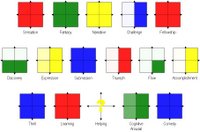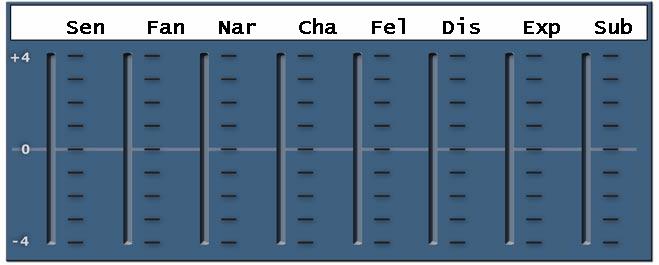Categories of Fun and Experience Design

"I'm bored." Two words we dread hearing from our kids, our students, our employees, and our customers. Wouldn't it be great if there was a handy pocket guide to putting the fun back into any situation? Last week I would have said "Don't hold your breath", and it's still probably not advisable, but by weaving together concepts from a number of realms I think that a usable set of tools is not out of reach.
The seed of hope was planted by She Who Must Not Be Photoshopped&trade's post on Congnitive Seduction. In the article Kathy points out that game designers are masters of the art of experience design, and references the work of Marc LeBlanc in particular. If you have any interest in experience design, go read this article right now! It's only 5 pages long, and you are cheating yourself out of a world of new understanding if you don't read it. Plus, the rest of this post will be incomprehensible without it (or more incomprehensible than my other posts; it's all relative). All done?. It was worth it, wasn't it?
The most important concept in the article is the MDA framework:


- Mechanics: design-time characteristics
- Dynamics: run-time characteristics
- Aesthetics: player experience
The second most important thing in the article is LeBlanc's list of aesthetics:
- Sensation - game as sense-pleasure
- Fantasy - game as make-believe
- Narrative - game as drama
- Challenge - game as obstacle course
- Fellowship - game as social framework
- Discovery - game as uncharted territory
- Expression - game as self-discovery
- Submission - game as mindless pastime
These aesthetics are meant to be a non-overlapping set, and Marc points out that various game experiences combine various aethetics (variously). Some examples:
Charades: Fellowship, Expression, Challenge
Quake: Challenge, Sensation, Competition, Fantasy
The Sims: Discovery, Fantasy, Expression, Narrative
Final Fantasy: Fantasy, Narrative, Expression, Discovery, Challenge, Submission
The exciting thing about the article is that the MDA model and set of Aesthetics are generalizable beyond just gaming. Kathy drafted a general typology of cognitive pleasures in her post. Another categorization of fun was published by Pierre-Alexandre Garneau in 2001. His categories are similar, but not identical to the others (and none of the authors claims that theirs is the Grand Unified Theory of Fun). Here is a simple table in which I tried to align similar types of aesthetics.
| LeBlanc | Sierra | Garneau |
| Sensation | Sensation | Sensation |
| Fantasy | Fantasy | Immersion |
| Narrative | Narrative | Immersion (passive) |
| Challenge | Challenge | Competition |
| Fellowship | Social Framework | Social Interaction |
| Discovery | Discovery | Discovery |
| Expression | Self-expression | Creation |
| Submission | ||
| Triumph | Power | |
| Flow | ||
| Accomplishment | Advancement and Completion | |
| Thrill | Thrill of Danger | |
| Learning | Learning1 | |
| Helping | Altruism1 | |
| Cognitive Arousal | Intellectual Problem Solving | |
| Comedy | ||
| Physical Activity2 | ||
| Application of an Ability2 |
1) added to the original list by MSU study team, but they make sense.
2) Purely physical fun not addressed by LeBlanc or Sierra
Looking at the list, there are some possible simplifications. Learning seems to align with Marc's notion of self-discovery. Yet learning isn't purely Expression. There are elements of Challenge and Discovery as well. In fact, most of the unique items on the other lists could be mapped to one or a combination of LeBlancian aesthetics. Take Thrill for example. It's a combination of Sensation, Challenge, and Discovery (heavy on the sensation). Try your hand at some of the others. For example, Garneau's Competition could be categorized as a combination of Challenge and Fellowship.
The point of the comparison is not to show the superiority of any one taxonomy. They each represent a useful level of abstraction for some purpose. Marc's is the most general-purpose, but requires the greatest adaptation of context to concept to be effective in the real world. Kathy's typology is designed as a practical list for people (like her) trying to develop passionate users for a product or service. Despite their differences, they both are designed as aids to understanding Experience Design.
A few years ago, Joseph Pine and James Gilmore wrote a book titled The Experience Economy
The diagram below outlines the difference between the categories of economic offering devised by Pine and Gilmore. The simplest offering, Commodities, is on the left, and the most sophisticated, Transformation, is on the right.
The four leftmost categories are pretty straightforward. When the book was written, Transformation was considered a nascent offering category. Not many people were billing based on lasting changes in other people's behavior - actually getting paid only when results were demonstrated. Weekly therapy sessions fall into the category of experience, since the patient pays whether they get better or not.
Pine and Gilmore defined the range of experiences along two axes:

The Passive vs. Active axis should be self-explanatory. Absorption vs immersion can be described this way: With absorption you're taking in the experience, with immersion you're diving in to create it.
I think we can all agree that most standard entertainment is passive-absorption. The show comes to you. In the opposite quadrant we have games like Final Fantasy and the Disney-themed derivative Kingdom Hearts, in which you wake up on the shore of an island and have to figure out how to navigate your way through a vast galaxy full of challenges, adversaries, and allies (most of them beautifully rendered Disney characters).
I can imagine Kathy Sierra doing her version of Munch's The Scream when we talk about Education being an Absorbtive experience! But be honest, most of today's education is just that. In the opposite (Aesthetic) quadrant we have a trip to the Metropolitan Museum of Art followed by dinner at the Rainforest Cafe.

Are we having fun yet? Which kind?

What would happen if we mapped the Categories of Fun onto the Experience Grid?

Come on! Try it. Click on the picture above to get a bigger version and try your hand at it. But remember:

Begin by asking yourself a few questions, like:
"Can you experience Challenge in a passive experience?"
"Can Flow be a part of an Absorbtive experience?"
"Which categories of fun apply to ALL types of experiences?
Here's my first cut at it: (click to enlarge)

I have to admit this mapping exercise was a lot less illuminating than I expected it to be. It turns out that Fun is Pretty Fungible&trade .
But that's a blessing in disguise, because it means we have great freedom in designing fun into experiences!
Which brings us back to the Mechanics-Dynamics-Aethetics model. One of the ideas in Marc's article is that game design should start with the desired aesthetics and work backward through dynamics to mechanics. That gives me an idea...
A while back, Kathy wrote a post about creating breakthrough products. She developed an equalizer-based model for comparing product features:
Kathy's equalizers included mechanics, dynamics, and aesthetics. What if we applied the MDA framework and began with a purely aesthetic set of sliders?

Let's try it out. Here are some examples:


It sure is! With this tool you can start to visualize opportunities for breakthroughs...
...that Sudoku is begging for a second aesthetic factor. Which one looks ripest to you?
[To be continued; that's plenty to digest in one sitting.]
posted by Mike at 12:40 PM

2 Comments:
Mike, I decided to go back to the beginning. I look forward to reading LeBlanc's stuff. I'll get back to you in a few days with some thoughts (I hope.)
Mark,
I'm sure you will enjoy Marc's work. It's brilliant and witty and fun!
And do, please, stop back again!
Mike
Post a Comment
<< Home